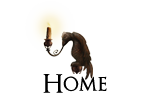Scribble City Central's twenty-seventh Fantabulous Friday comes from Ann Halam (or as some of you may know her better, Gwyneth Jones). I first came across Ann's writing when I was an editor at Orchard Books. Her novel King Death's Garden was on our very first list there, and I still have a treasured copy of it on my bookshelf. The Daybreaker and its sequels were the first fantasy books I ever worked on, and I learned a great deal from Ann's meticulous attention to world-building detail which would stand me in very good stead when I jumped the fence and became a writer myself.
It was therefore, with much pleasure that I discovered Snakehead, her retelling of the Perseus myth, some years later. Being a refashioner of Greek myths myself, I'm a pretty harsh critic, and it has to be good to impress me. Snakehead does the business admirably, pulling off the tricky job of making the reader see an old story in a new light, and from a different angle. If you are a fan of, say Madeline Miller's Song of Achilles, or Adele Geras' Troy, this is one you'll enjoy. I can't think of anyone better than Ann to hold a mirror up to the Gorgon sisters, and shall now pass you over to her to reveal all about:
M for Medusa
Scary Snakehead Sister
AH: In Greek and Roman Mythology, Medusa is one of three sisters called The Gorgons: daughters of two very ancient Greek sea deities called Phorcys and Ceto, who had a whole brood of monster children. Together, this family represents all the terrors of the ocean. But the Gorgons, Euryale, Sthenno and Medusa, lived on land, guarding the Golden Apples in the Garden of the Hesperides. Their form was human, but they had snakes for hair, invulnerable scaled skin, wicked fangs, hands “made of brass”; and their blood was deadly poisonous. And their big, flashing eyes had a glance that turned anyone who looked on them to stone.
Euryale and Sthenno were immortal, but Medusa was not...
The hero Perseus, son of Zeus, who had grown up incognito on the island of Serifos, was tricked by the tyrant ruler of the island into agreeing to go on a quest, and bring back the Gorgon’s Head. The tyrant, Polydectes had designs on Perseus’s young mother (who was Danae of the Shower of Gold, the imprisoned princess in another story). Obviously he’d spotted that a grown-up Perseus would be a problem, and wanted to get rid of him. But the Goddess Athini (Athene) intervened. She gave Perseus a weapon, the sacred harpe, a mirror-bright shield, a Medusa-proof pouch in which he could safely carry the loot; and detailed instructions on how to kill the monster and get away with it... So instead of becoming a statue in the Gorgons’ Garden, Perseus returned to the island with the terrifying Snakehead, plus a highly eligible princess of Ethiopia called Andromeda. He turned Medusa’s stone-striking gaze on bad-guy Polydectes and his cronies —taking aim safely by looking in the mirror-shield. Serifos was freed from a tyrant, while Perseus and Andromeda went on to found the great city of Mycenae; Homer’s well-built Mycenae rich in gold... And a dynasty of rule in direct ancestral line to classical Athens itself.
Meanwhile Athini took the Severed Head of the Medusa, and placed it in honour on her shield, as a symbol of her ferocious protective power. Perseus and Andromeda are also famous for being the only pair of lovers in the entire Mythological Cosmos of ancient Greece to live happily ever after.
I expect I first met the story of Perseus and Andromeda in a collection of Greek Myths and Legends, when I was a child. I didn’t think much of “Greek Myths” at the time: I far preferred fairytales, because Fairytales were proper stories, with adventures and exciting plots, and people you could care about, whereas anyone could tell the Myths were just educational pictures in words: useful information about the world, dressed up as memorable monsters and mighty divinities.
Later in life I travelled to Greece, and the islands of the Aegean, and fell in love with the story of Perseus and Andromeda, because I realised that this, “the greatest of all the Greek myths” is a proper story, maybe the ancestor of all fairytales. It has so many connections, so many trails you can follow. On one level it’s a hero-tale, on another it’s a “myth of origin” the Athenians invented, or adopted, for their city, but it seems to hold within it mystery and buried treasure far older than that. The Medusa is a terrifying monster, yet she’s also described (in the most ancient sources, not just in later versions), as a beautiful woman. She’s a fearsome Weapon of Mass Destruction, but when you look at her in a mirror; when you reflect on her, she’ll do you no harm, and her beauty is restored. She’s a Gorgon, which means Horror, but her name (Medusa) means Protection.
A lot has been written about how the Medusa symbolises Woman, and how Woman has two faces, the terrifying monster mother who steals Man’s potency (Freud), and the beautiful protective mother. It’s also said that the myth of the Medusa’s “defeat” represents the fall of ancient matriarchal culture around the Mediterranean, and the triumph of patriarchy. Me, I don’t think so. I find this is an unnecessary fabrication. The myth of the Medusa is a very ancient myth, predating that particular battle of the sexes. It’s about being human, about the frightening and double-faced powers of a thinking being. The fact that the monster and the protector are both female, in this story, is a puzzle only if you can’t imagine a world in which the people making up the stories were women themselves...
My version of the Perseus and Andromeda story (Snakehead) reflects my love of travelling around the Greek end of the Mediterranean, and my respect for the heroism of fairytale princesses; Andromeda plays an important part. But it equally reflects my respect for the Medusa, and for the wise storytellers who knew already, long ago, that all the worst monsters we invent come from the depths of our selves, and from the conflict of our divided nature: the powerful animal that thinks.
SCC: I hadn't thought of the Medusa/Perseus/Andromeda story as the 'ancestor of all fairytales' before, but it makes perfect sense. Thank you for visiting and for providing so much interesting food for thought with this post, Ann.
You can buy Ann Halam's Snakehead by clicking HERE
Next week: Liz Kessler frolics with M for Mermaids. Bring a swimsuit!



































